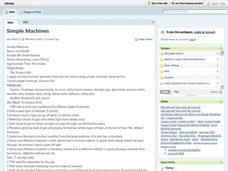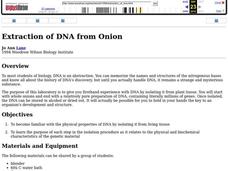Curated OER
Applied Science - Physics Pre-Lab
Students view a static electricity demonstration. For this Physics lesson, students compare static and current electricity. Students watch an electricity slide show and sing the Electricity song.
Curated OER
Physical and Chemical Properties of Matter
Learners identify the physical and chemical properties of matter. They review the types of matter. Students list the four states of matter (Solid, Liquid, Gas and Plasma). They recognize and describe the different types of matter.
Curated OER
A New Phase In Town
Middle schoolers explore heat energy and how it is used to change the phase of matter, and discover that temperature does not increase or decrease until the phase change is complete. This extremely well-written plan is packed with great...
Curated OER
Healthy Field Day
Hosting a Healthy Field Day will take a lot of planning and organization, but with a lot of parent participation it can come together very well. The resource describes seven stations of the ten that were presented. Each of these has a...
Curated OER
Mapwork: A Place In the News
Students determine how to find geographic information about places they read about in the news. For this geography lesson, students look at political and physical maps to determine the difference. They access maps online to find the...
Michigan State University
Gases Matter
Young scientists learn that seeing isn't necessarily believing when it comes to the states of matter. After performing a fun class demonstration that models the difference between solids, liquids, and gases, children complete a series of...
Curated OER
Simple Machines
Students engage in a lesson that is concerned with the concept of a simple machine and uses the law of motion to justify why they operate. Students explore the laws by constructing some simple machines to illustrate the concepts.
Curated OER
Extraction of DNA from Onion
Students study DNA by isolating it from plant tissue. They determine the purpose of each step in the isolation procedure as it relates to the physical and biochemical characteristics of the genetic material
Curated OER
Electricity Shortage
Students use the Internet to discover what electricity is and how it is made. They examine a site that discusses electricity and magnetism. They discover the ways electricity can be generated.
Curated OER
Conductors and Insulators
Fifth graders explore conductors and insulators. In this science lesson, 5th graders act as electrons moving through a wire. Students break into groups representing conductors and insulators and explore how they work with electrons.
Curated OER
Magnetic Field Activities
Students explore the idea of magnetic field through investigations of magnetic fields as produced by various common magnetic materials and direct currents. They study the vector nature of fields, the ubiquity of field sources in the...
Curated OER
P.L.E.P: Parts of Blood
Students examine the different parts of blood. In this human blood lesson students work in groups and identify parts of blood and construct a model of human blood.
Curated OER
Plate Tectonics
Students identify that most of mountain ranges found on all major land masses and in the oceans are external reflections of tectonic movements within the earth. They identify that earthquakes and related phenomena are caused by the...
Curated OER
Extraction of DNA from Onion
Students experiment with DNA by isolating it from plant tissue. They investigate whole onions to prepare DNA. They complete the experiment to examine the structural characteristics of DNA.















